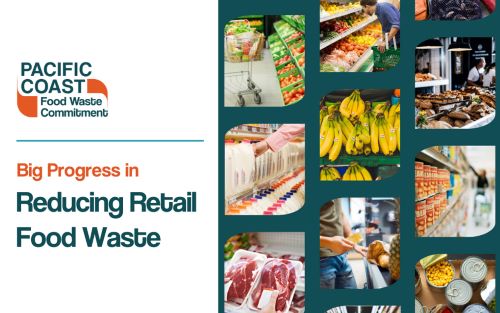West Coast Grocers Reduce Food Waste

West Coast grocery retailers have made progress reducing the amount of food that goes unsold from their stores, according to a new report.
The Pacific Coast Food Waste Commitment said in its 2023 Year-End Report that 3.2 percent of the food in the regional grocery stores that it tracks in California, Oregon, and Washington went unsold in 2022, a decrease from 3.8 percent in 2021. Since the PCFWC began collecting retail data in 2019, unsold food rates in the region have decreased by 28 percent through 2022. The unsold food rate was nearly 4.5 percent in 2019.
“While we have seen many positive indicators, this is by far the largest proof point we’ve ever seen using actual data that’s pointing to real food waste reductions at scale,” said Dana Gunders, executive director at ReFED, which is one of the resource partners of the PCFWC.
The PCFWC tallies data from retailers that comprise about 50 percent of the region’s grocery market share. The initiative was created by the Pacific Coast Collaborative, an organization seeking to promote a low-carbon economy in the region. The PCC aims to reduce greenhouse gas emissions by 80 percent by 2050.
Retail signatories to the PCFWC include Albertsons, Aldi, Kroger, New Seasons Market, PCC Community Markets, Raley’s, Sprouts Farmers Market, and Walmart. It also includes foodservice providers Aramark, Compass Group, and Sodexo, distributor Organically Grown Co., manufacturers Bob’s Red Mill, Food Northwest, and Lamb Weston, and grower Del Monte.
In addition to ReFED, the PCFWC also lists as resource partners Cascadia Policy Solutions, Wrap, and the World Wildlife Federation.
Waste by Category
The 2023 Year-End Report found that unsold food rates remained highest in the prepared foods and breads/bakery departments in 2022, at 8.38 percent, and 8.06 percent, respectively. The two departments are moving in opposite directions, however, as the rate of unsold prepared foods has fallen by more than three percentage points since 2019, while the rate of unsold food in the bread/bakery category has inched upward.
The percentages of both unsold produce and fresh meat/seafood have also declined from 2019. The other categories tracked by the report all have less than 2.5 percent unsold product.
In terms of the overall volume of unsold food, the produce department continues to contribute the most unsold food by weight with 37.2 percent of the total share.
In 2022, the PCFWC region produced an estimated 22.5 pounds of unsold food per capita, a 24 percent decrease from 29.7 pounds per capita in 2019.
Donations Increase Steadily
The report showed that donations have increased slowly but steadily since 2019, accounting for 15 percent of the total of unsold food in 2022, slightly less than landfills.
Albertsons is among the PCFWC signatories that have stepped up their efforts around reducing food waste by finding better end uses for its excess product.
“In addition to donating unsold food, we’ve implemented several tactics such as working with Afresh to implement their artificial intelligence-based technology to help us order the right produce in the right quantities; partnering with Uber to address local donation pickup challenges through sponsored delivery at select stores; and for food that can’t be sold or donated, diverting that food to animal feed, anaerobic digestion or composting, said Suzanne Long, chief sustainability and transformation officer, Albertsons Cos.
Grocery stores can send their unsold food to a variety of destinations, which are ranked according to the Environmental Protection Agency’s new Food Waste Scale. This scale prioritizes actions that keep food in the human supply chain, such as donations or use as animal feed, which are preferred over composting or anaerobic digestion. Landfills, sewers, and incineration are at the bottom of the scale.
The report also examined the total carbon footprint of unsold food in the region, which was down 30 percent from 2019 to 2022. This footprint includes both the upstream contributions from the supply chain activities required to get food from production to retail, as well as the downstream contributions from the destinations of unsold food.
Fresh meat/seafood, which has the highest emissions factor of any category in the store, had a 36 percent decline in unsold tonnage from 2021 to 2022, contributing significantly to the decline in the overall carbon footprint.
Tests Seek New Ways to Cut Waste
The PCFWC also completed several “intervention projects” during the past year, which included a test involving minimizing waste of two key produce items: fresh strawberries and frozen potatoes. The project was the first of its kind for the organization in that it involved two suppliers and three major retailers in order to identify waste-reduction solutions across supply chain partners.
The project found that 36 percent of the total loss for fresh strawberries was at the farm stage, where berries are often rejected for not meeting size or quality standards, or because of labor constraints. One potential solution proposed was to test “bulk harvesting” and create new product lines for retailers that can use the smaller or imperfect strawberries.
Frozen potatoes, meanwhile, experience between 21 percent and 38 percent of total loss at the processing plant. Recommendations for the next steps were to gather more data at each stage to determine which edible byproducts or out-of-spec items would best be targeted for upcycling opportunities.
Other intervention projects included a partnership with the city of Oakland to increase adoption of composting and recycling; an effort at Aramark and Sodexo locations to increase messaging around food waste, and soliciting employee engagement on food waste reduction at Land O’Lakes.
